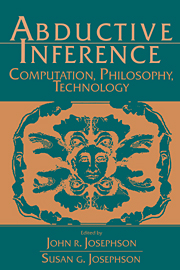Book contents
- Frontmatter
- Contents
- Contributors
- Introduction
- 1 Conceptual analysis of abduction
- 2 Knowledge-based systems and the science of AI
- 3 Two RED systems – abduction machines 1 and 2
- 4 Generalizing the control strategy – machine 3
- 5 More kinds of knowledge: Two diagnostic systems
- 6 Better task analysis, better strategy – machine 4
- 7 The computational complexity of abduction
- 8 Two more diagnostic systems
- 9 Better task definition, better strategy – machine 5
- 10 Perception and language understanding
- Appendix A Truth seekers
- Appendix B Plausibility
- Extended Bibliography
- Acknowledgments
- Index
2 - Knowledge-based systems and the science of AI
Published online by Cambridge University Press: 08 October 2009
- Frontmatter
- Contents
- Contributors
- Introduction
- 1 Conceptual analysis of abduction
- 2 Knowledge-based systems and the science of AI
- 3 Two RED systems – abduction machines 1 and 2
- 4 Generalizing the control strategy – machine 3
- 5 More kinds of knowledge: Two diagnostic systems
- 6 Better task analysis, better strategy – machine 4
- 7 The computational complexity of abduction
- 8 Two more diagnostic systems
- 9 Better task definition, better strategy – machine 5
- 10 Perception and language understanding
- Appendix A Truth seekers
- Appendix B Plausibility
- Extended Bibliography
- Acknowledgments
- Index
Summary
The science of AI
The field of artificial intelligence (AI) seems scattered and disunited with several competing paradigms. One major controversy is between proponents of symbolic AI (which represents information as discrete codes) and proponents of connectionism (which represents information as weighted connections between simple processing units in a network). Even within each of these approaches there is no clear orthodoxy. Another concern is whether AI is an engineering discipline or a science. This expresses an uncertainty about the basic nature of AI as well as an uncertainty about methodology. If AI is a science like physics, then an AI program is an experiment. As experiments, perhaps AI programs should be judged by the standards of experiments. They should be clearly helpful in confirming and falsifying theories, in determining specific constants, or in uncovering new facts. However, if AI is fundamentally engineering, AI programs are artifacts, technologies to be used. In this case, there is no such reason for programs to have clear confirming or falsifying relationships to theories. A result in AI would then be something practical, a technique that could be exported to a real-world domain and used. Thus, there is confusion about how results in AI should be judged, what the role of a program is, and what counts as progress in AI.
It has often been said that the plurality of approaches and standards in AI is the result of the extreme youth of AI as an intellectual discipline.
- Type
- Chapter
- Information
- Abductive InferenceComputation, Philosophy, Technology, pp. 31 - 62Publisher: Cambridge University PressPrint publication year: 1994



